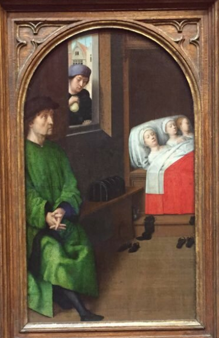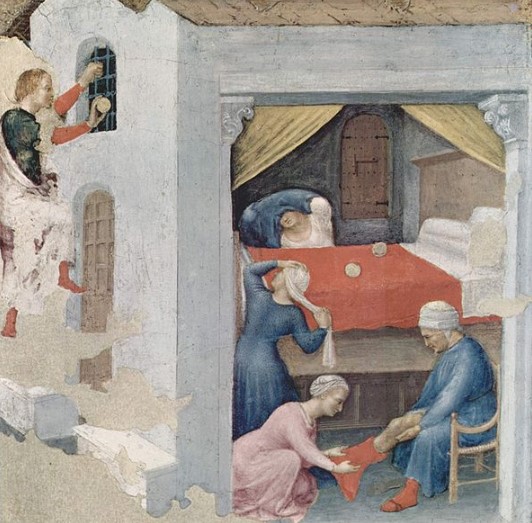Today is St Nicholas Day! Hooray! As a person of the Czech persuasion, St Nicholas day (or Mikuláš) has long been a thing for me, celebrated in the family with stockings full of sugar and oranges, and if you’re lucky enough to be in CZ with a huge-ass street party where everyone is dressed up like St Nicholas, angels, and demons, and enjoys freaking kids out like so:

Now St Nicholas day itself may not be all that important to most of us who were not blessed enough to be Czech or related to Czechs, but we are generally aware of him because it’s the St Nicholas legend that gave birth to Santa. We often use Santa and St Nicholas as interchangeable, after all, ‘tis the season and all that.
I thought that on his feast day we might have a quick little chat about the life of St Nicholas so you can understand how none of this street party stuff really relates AT FUCKING ALL, but why none of that matters.
SO! We talked a little on twitter about this back in October, but in Edinburgh at the National Portrait Gallery there hangs this absolutely gorgeous triptych of the life of St Nicholas by Gerard David:

Most probably painted in the very early sixteenth century, this painting is remarkable because it shows us what medieval people thought was important about St Nicholas. Historians today would likely focus on the drier aspects of his life. The man was the Bishop of Myrna in Asia Minor in the fourth century. He may or may not have been at the first Council of Nicea in 325 and punched Arius – the father of the Arian heresy! (FYI it’s not that sexy a heresy and has to do with the nature of the Godhead. Sorry.)
Anyway that is extremely not what David wanted to you to think about. Let’s break down what he was all about.

First off, we see that David wanted you to know that from birth St Nicholas was absolutely GOING FOR IT in the holy department. He’s ready to stand the fuck up and start praying immediately. That is the good stuff for David because it shows St Nicholas’s remarkable affinity with the divine. Even before he is taught anything about the world he is aware of holiness and ready to throw down on it. He can also overcome the weakness of ordinary humans and stand because of his holiness. This is Extremely Good for medieval people interested in saints. This is because more of less the veneration of saints was about finding a friendly intercessor for yourself with God. Now saints were human, and so understood that the hustle was hard. However, they were also able to overcome it and were in the presence of God. So, if you prayed to a saint, they might be able to petition God on your behalf to let you out of purgatory earlier when you got sent there for wanking. It is good for saints to be human, but you don’t want them to be too human, you know? If they aren’t holy AF can you really be sure that they are actually hanging out with God and a worthy intercessor. This panel is basically telling you, don’t worry, St Nicolas is defo Extremely Holy and someone you can do to for help. (You perv.)

In the central panel we see St Nicholas performing one of his most famous good works. You can see him here in the window about to put a sack full of money into the shoes of three sleeping girls. According to his hagiography, St Nicholas got wind of three sisters (the sleeping girls) who were about to become sex workers because they could not afford a dowry to get married. The girls weren’t very psyched at the situation, but they and their father (your man in green) were proud, and so St Nicholas decided to just slip them the money necessary for a dowry. Now they could get married instead of being sex workers! Which is different! Because being a baby machine and owing your husband something literally called a “marital debt” where you have to have sex with him is defo different. Yessir.
I, obviously, love this panel because it gives us an opportunity to reflect, once again, on the differences in the medieval approach to “rescuing” women from sex work and our current one. Then as now there was definitely a concept of sex work as something that was bad for women. That is because once again just like now, women were perceived as having value as a sexual commodity for potential husbands. You don’t want to be a sex worker because then you are not a wife and mother, which is what the ladies is for, amiright? However, in the medieval period people also understood that any woman who is a sex worker reluctantly is probably there because of her material circumstances. Sex work is one of the only types of work always open to most women and one that doesn’t require any intervention or control from men. So if you want to help a woman to not do sex work, you better come out your pockets and give her some money so that she has other options.
Suffice to say, that is not the approach we favour now, which is mostly yelling about empowerment and trying to shame sex workers into other lives. Anyway, the point is my boy Nicholas knows what’s up, and so did medieval people. They wanted to celebrate good works like this, and really saw giving women options as a definitive holy act. St Nicholas helping these women out is one of the reasons that we associate him with Santa Claus. He left gifts while sleeping. Real good ones too. Yay!

The last panel, though, is absolutely brilliant because it shows us what medieval people were absolutely the most here for – a miracle. The panel commemorates a story that late medieval people pretty much invented and which we have no records of previously. According to the legend, St Nicolas was doing his bishop thing during a famine and came upon a bishop who was saying that somehow he was still selling ham. St Nicolas, was like, where’d you get the pigs at bro? When the butcher couldn’t answer, St Nicholas knew something was up and busted into the butcher’s shop. There he found three murdered boys in a barrel being salted down and cured to be sold as ham. St Nicolas was like hell no, and brought the boys back to life by making the sign of the cross over them.
This was absolutely the story about St Nicolas in the late medieval period and you see it reproduced all the time, like so:

This story, and the association of St Nicolas with the boys, is why St Nicolas is the patron saint of children. (The barrel also made him the patron saint of brewers, even though it is clearly not that kind of barrel, but whatever.)
It also tells us that what medieval people valued the most about saints was miracles. What was the point of a saint at all if he or she couldn’t produce a miracle for you? It’s all well and good that St Nicholas was doing acts of charity and maybe punching heretics at synods (Side note: where is the picture of St Nicolas punching Arius that I both need and deserve? Honestly.), but what people wanted was saints to make with the miraculous. Why pray to someone if they couldn’t even hook you up with a miracle now and then? That is the whole point! So yeah sure, boys being salted down as ham. Whatever it takes, baby!
Anyway probably none of this tracks with your idea of what St Nicholas is now. For why and how come? Well, a very over-simplified version is that over the years we have kept the idea that St Nicholas gives secret gifts while you sleep, and we have combined it with the whole patron saint of children thing and turned him into someone who gives gifts to children while they sleep. We’ve taken out the sex workers and murder of young boys and created a fluffy easy legend that does what we in a neo-liberal capitalist society want – gives us an excuse to buy shit. That’s not what medieval people wanted. They wanted someone as a model for charitable giving, and someone they could ask for holy intercession.
All in all St Nicholas, then, is a great example of how societies relate to concepts of sanctity and change those stories over time to suit them. He also represents a great opportunity to think about how we offer help to those who need it, respect the lives of sex workers, and ideally do not eat children when we are hungry.
Most importantly, though, St Nicholas gives us a great reason to celebrate, however we see fit. Šťastný Mikuláš, kamárdi!!!
If you enjoyed this, please consider contributing to my patreon. If not, that is chill too!
For more on saints, see:
My fav Saints: St Procopius of Sázava, a spooky saint
On Michaelmas
On martyrdom and nationalism
My fav saints: St Wenceslas
My fav [not] saints: St Guinefort
For more on sex workers in the medieval period, see:
On the Agas map of London, medieval and early modern cities, and life
On sex work and the concept of rescue
These hoes ain’t loyal – on prostitutes and bitches in medieval and hip hop culture
Sex and the (medieval) city: social hygiene and sex in the medieval urban landscape
For more on Christmas traditions in the medieval period, see:
On the medieval secret to a balling Christmas for once
For more on medieval religion, see:
Religious iconography has always been a prop
On Odious Debt
My fav [not] saints: St Guinefort
Emergency post: That is not what Good Friday means
JFC, calm down about the medieval Church
On Prague, preaching, and brothels
On “the way of carnal lust”, Joan of Leeds, and the difficulty of clerical celibacy
On dildos and penance
A short history of Jan Hus, the Protestant leader you’ve never heard of
Islam was the party religion, or, why it is lazy and essentialist to say that Islam oppresses women
On No Nut November
Considering bad motherfuckers: Hildegard of Bingen and Janelle Monáe
Emergency Pubcast – Why the Pope can’t just say there is no hell and do me like that
On Mike Pence, Holocaust Memorial Day, and Christian interpretations of Jewish utility
Keep the word ‘Judeo’ out of your racist mouth Nigel Farage
On the medieval separation of church and state, or, putting the ‘holy’ in Holy Roman Empire
On Jerusalem and the Apocalypse, or why you should be deeply unsettled right now
Look up – this church is judging you


. According to the legend, St Nicolas was doing his bishop thing during a famine and came upon a – bishop – who was saying that somehow he was still selling ham. St Nicolas, was like, where’d you get the pigs at bro? When the butcher…
– butcher – ?
LikeLike